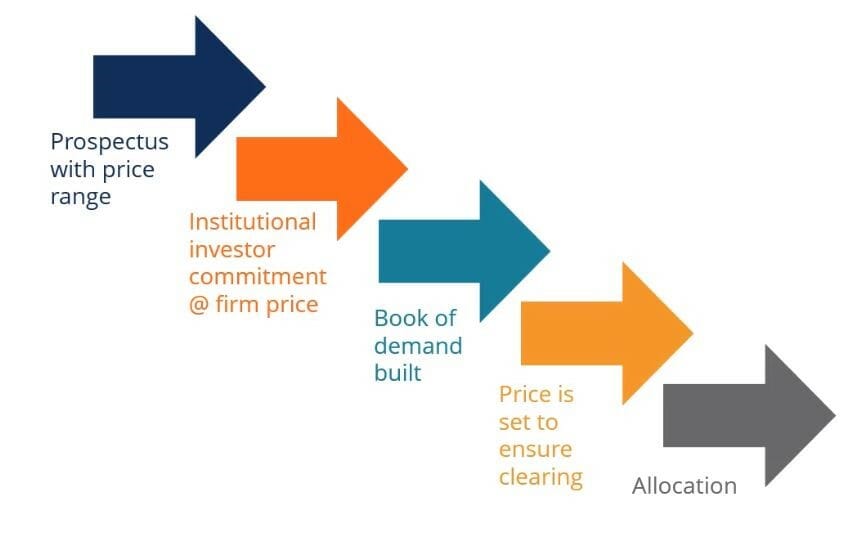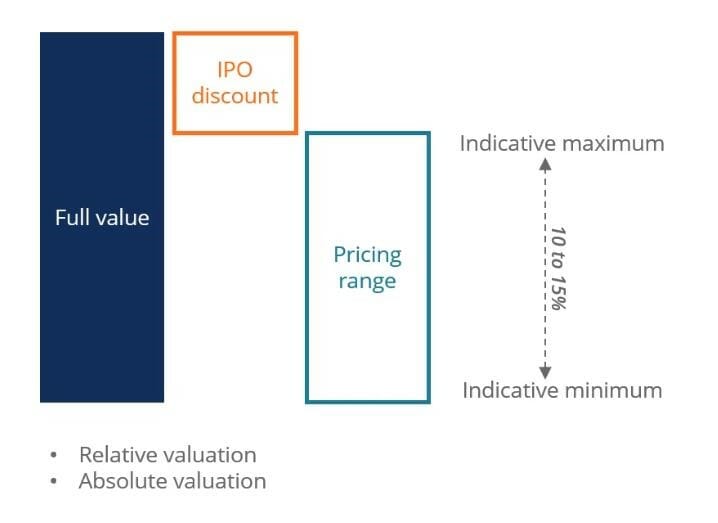Capital Raising Process
Capital Raising Process – An Overview
This article is intended to provide readers with a deeper understanding of how the
capital raising process works and happens in the industry today. For more
information on capital raising and different types of commitments made by the
underwriter, please see our underwriting overview.
Book Building Process
During the second phase of underwriting advisory services, investment bankers must
estimate the expected investor demand. This includes an evaluation of current
market conditions, investor appetite and experience, news flow, and
benchmark offerings. Based on all these conditions, investment bankers or
underwriters will draft a prospectus with a price range that they believe is
reflective of expected investor demand. Then, combined with institutional investors’
commitment, the underwriter will narrow the offering to a firmer price.
As investment bankers receive orders at certain prices from institutional investors,
they create a list of the orders, called the book of demand. From this list,
investment bankers will justify and set a clearing price to ensure the entire offering
is sold. Finally, the allocation of stocks or bonds will occur based on the subscription
of the offering. In the case of an oversubscribed book, some investors may not
receive the full requested order.

Roadshow for the Capital Raising Process
The roadshow is often included as a part of the capital raising process. This is when
the management of the company going public goes on the road with investment
bankers to meet institutional investors who are – hopefully – going to be investing
in their company. The roadshow is a great opportunity for management to convince
investors of the strength of their business during the capital raising process.
These are some critical factors for a successful roadshow:
1. Understanding the management structure, governance, and quality
Investors are adamant that management structure and governance must be
conducive in order to create profitable returns. For a successful roadshow,
management must convey efficient oversight controls that exhibit streamlined
business procedures and good governance.
2. Understanding key risks
Although risks aren’t positive, management must highlight and be upfront
about the risks involved. Failure to report any key risks will only portray their
inability to identify risks, hence demonstrating bad management. However,
management should emphasize their hedging and risk management controls
in place to address and mitigate the risks involved in carrying out their business.
3. Informing about tactical and long-term strategies
Informing investors about the management’s tactical and strategic plans is
crucial for investors to understand the company’s future growth trajectory.
Will management be able to create sustainable growth? What are the growth
strategies? Are they aggressive or conservative?
4. Identifying key competitors
Again, although competition isn’t a positive factor, management must clearly
address the issue with investors. When discussing key competitors, management
should lead the conversation to how their competitive advantage is, or will be,
more superior than that of their competitors.
5. Outlining the funding purpose and requirements
Why does the management need more cash? How, specifically, will the
money be used?
6. A thorough analysis of the industry/sector
Investors want to not only understand this company, but also the industry.
Is it an emerging market? What is this company’s projected growth compared
to that of the overall industry? Are the barriers to entry high or low?
Pricing
Even though investment bankers devote substantial amounts of thought and
time in pricing the issue, it is extremely challenging to predict the “right” price.
Here are some key issues to consider in pricing.
1. Price stability
After the offering is completed, investors do not want a lot of volatility.
High levels of volatility will represent that the security was valued incorrectly
or unreflective of the market’s demand or intrinsic value.
2. Buoyant aftermarket
If there is to be any price volatility after the issue, hopefully, it will be to the
upside. A strong post-issue performance indicates an underpriced offering.
3. Depth of investor base
If an offering attracts only a few highly concentrated investors, the probability
of price volatility will be high. The deeper the investor base, the larger the
investor pool, the more stable prices are likely to be.
4. Access to market

Pricing Tradeoff
Choosing the “right” price requires a tradeoff between achieving a strong
aftermarket price performance and underpricing. Therefore, an investment
banker should price the offering just low enough for a strong aftermarket
performance, but not so low that the issuer feels the offering is substantially
undervalued.
Costs of Underpricing
Underpricing an issue reduces the risk of an equity overhang and ensures a
buoyant aftermarket. Then why wouldn’t underwriters want to underprice
every time? In short, underpricing an offering is simply a transfer of surplus
from the issuer to investors. The issuer will incur an opportunity cost from
selling below its value, while investors will gain from buying an undervalued
offering. As banks are hired by the issuers, the underwriters must in good faith
make the best decisions and returns for the issuer by correctly balancing the
tradeoff.

IPO Pricing
In order to price an IPO, banks must first determine the full value of the company.
Valuation is done by a combination of Discounted Cash Flow (DCF), comparable
companies, and precedent transactions analysis. For more information on business
valuation and financial modeling, please see our financial modeling guide and
Once investment bankers determine the value of the business through these
financial models, they deduct an IPO discount. Hence, in IPOs, there is usually
a discount on the intrinsic or full value of the business to price the offering.
The full value minus the IPO discount gives a price range that investment
bankers believe will attract institutional investors. Typically, 10%-15% is a
normal range for the discount.
However, exceptions always exist. In the case of a heavily oversubscribed offering,
the excess demand may offset the IPO discount. On the other hand, if the demand
is lower than expected, it may be re-priced below the expected price range.

Additional Resources
Thank you for reading CFI’s guide to the capital raising process. To learn more
about corporate finance, check out the following free CFI resources:
M&A Modeling Course
Learn how to model mergers and acquisitions in CFI’s M&A Modeling Course!
Build an M&A model from scratch the easy way with step-by-step instruction.
This course will teach you how to model synergies, accretion/dilution, pro forma
metrics and
a complete M&A model. View the course now!
